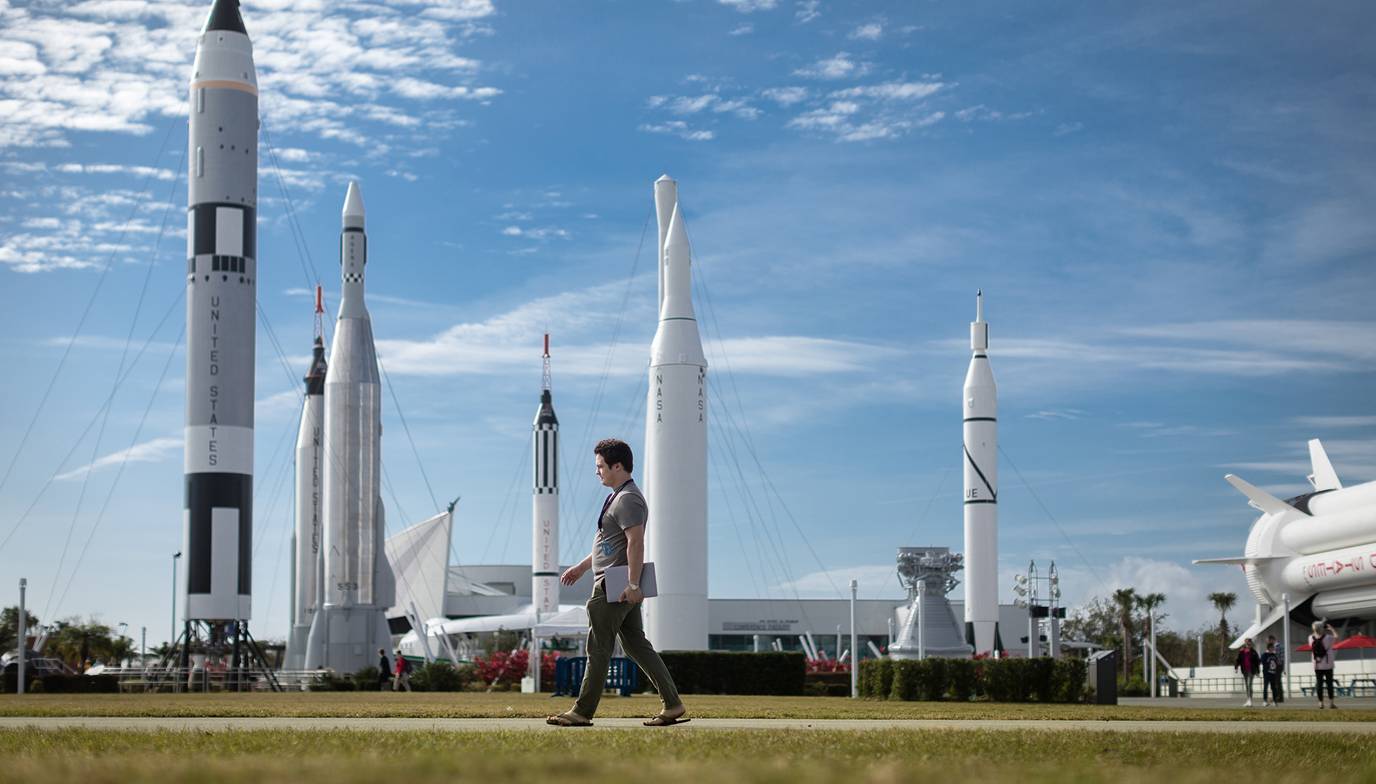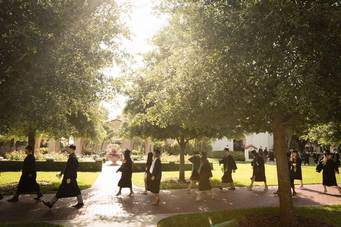Rocket Man
March 26, 2018
By Rob Humphreys ’16MBA

Three straight internships at NASA have given Michael Gutensohn ’18 real-world experience that’s out of this world.
It’s a clear blue day at Kennedy Space Center as computer science major Michael Gutensohn ’18 examines the world’s most powerful deep-space propulsion system, one that will eventually launch astronauts aboard the Orion spacecraft on missions to Mars.
A moment later he’s miles away, floating above an equally impressive rocket, the SpaceX Falcon Heavy. Then it’s up to the roof of the Vehicle Assembly Building, just to enjoy the view.
Amazing what you can do these days without even leaving the office.
This spring, Gutensohn began his third internship for NASA, working 45 miles from campus in the Augmented Virtual Reality Lab at Kennedy Space Center. The same computer-vision concepts he’s honing at Rollins—where he created a camera-based parking-optimization system for his senior capstone project—are the foundation of his work at NASA on 3-D facial and object recognition.
In previous internships at NASA, Gutensohn handled software development at the Jet Propulsion Lab in California and computer engineering at KSC’s Grounds Systems Development and Operations Program. After graduation, he plans to follow in the footsteps of professor Valerie Summet, pursuing a master’s degree in human-computer interaction.
A Valencia College transfer and the sixth of 10 children, Gutensohn has worked 40 hours a week since high school. So he enjoys the flexibility of taking evening courses at Rollins’ Hamilton Holt School, where small classes give him up-close access to some of the brightest minds in the field—professors and classmates who are helping him launch a career where not even the sky’s the limit.

NASA has to be one of the world’s coolest internships. What’s it like interning at NASA? “I had gone to Kennedy Space Center for the first time with my little brother in January 2017, and walking out there I said, ‘I’m gonna work here one day.’ Now, every morning, driving toward that big Vehicle Assembly Building, I never get over the fact I’m working at NASA. It’s a highly sought-after opportunity, given the topic. A few hundred applicants applied.”
Your first internship was at the Jet Propulsion Lab. How did you end up interning in California when Kennedy Space Center is right in our backyard? “I had actually applied for a different position at NASA. But they called and asked if I’d like to interview for the job in California, and it just aligned with my interests perfectly. Two of my professors had written letters of recommendation, and that helped put me through. I was very blessed to have that kind of support.”
You had quite the adventure in California, starting with a great American road trip. Tell us more. “I had never driven out of Central Florida by myself, so I decided I’d like to have my car with me because I’m a very independent person and wanted to be mobile. It was an amazing trip. I enjoyed every minute of it. I took a ton of pictures and even took a detour to the Grand Canyon. I’m an amateur astrophotographer, so I’m sitting out on a cliff waiting for the sun to set, and all the stars came out, and it was just flabbergasting. I lived out of an RV I rented from a guy on Airbnb in the middle of downtown Silver Lake, California. There was no plumbing or AC, just a gas stove and a propane refrigerator. As miserable as all that sounds, I actually loved every bit of it. I went to Caltech’s gym to use the bathroom and shower. I got a good workout every morning.”
What were you working on at the Jet Propulsion Lab? “One of my first projects was working with the User Interfaces Group on a simulated version of the Deep Space Network’s interface software. I started at zero and got to build something from the ground up. It was fun—the first time I really felt like a developer. It really gave me a more holistic view of the development processes I was studying at Rollins.”
Do you think your Rollins education gave you a leg up? “The liberal arts and engineering are more tightly knit than people think. Their paths cross quite a bit. In computer science, it’s just as much of an art as a science. I used to hate having to write papers, but it’s such an important skill for anyone in a STEM field. Additionally, the interpersonal skills I’ve gained from attending Rollins definitely give me an edge. I’ve been able to talk through design decisions with clients and users, asking questions other developers might not know how to ask.”
What’s the biggest strength of Rollins’ computer science program? “Its size. Because it’s such a small, tight-knit group, you can’t go without learning people’s names and building a relationship with the professors—and that sets it apart from larger schools. The program has taught me to continue learning on my own, to go out and research new things beyond the classroom.”
Anyone who’s spent time on campus will appreciate the senior capstone project you completed last spring. How would your parking-optimization system benefit drivers? “The assignment was to solve a problem on campus, so my group picked parking. We utilized computer vision and a back-end web system to monitor the available parking spaces. We built a demo version for the class that focused on four spots in the parking garage with one pole-mounted camera. We want to integrate the system with Siri or Google Assistant so people can ask what spots are available and where. It was difficult but tons of fun.”
Some of the technology that fascinates you most carries deeply personal promise. How has your mother’s visual impairment affected your fields of study? “My mom has a genetic, deteriorative eye disorder called retinal pigmentosa that’s caused her to be 97 percent blind. She found out about the condition when she was 12 or 13, and the doctor said she’d be blind by 30. But thankfully, with advancements in medical technology, they’ve been able to save some of her vision. I’m not a medical person, so I couldn’t find a cure for it. But I’d definitely like to design tools and technology that can be used by everyone. So getting into stuff like voice assistance would be very cool. Audio interfacing is something I’m very interested in, things like Google Home, Siri, and Alexa.”
What advice would you give to students following in your footsteps? “Take advantage of your resources and be passionate. Be ready to exceed expectations as an intern. Build the best thing you can in the time you have. As a student, bug the heck out of your professors, join study groups, and become a part of Rollins’ chapter of the Association of Computational Machinery.”

Rollins Results
From our innovative curriculum to our commitment to career services, find out how Rollins prepares our graduates to lead meaningful lives and forge productive careers.
Read More
July 08, 2024
Gunter’s Book on Climate Change Receives Multiple Awards
Political science professor Mike Gunter’s book Climate Travels recently won awards from Foreword magazine and the American Library Association.
June 27, 2024
Lahlou ’24 Earns Boren Scholarship
Adam Lahlou ’24 has earned a Boren Scholarship, a prestigious award reserved for students who intend to pursue careers in federal national security.
June 17, 2024
A Path to Purpose
Falecia Williams ’91 expanded her world by earning a Rollins degree. Now, she is working to expand the worlds of thousands of college students.
